What’s a NOCA? It’s the four letter code for Northern Cardinal. The code was devised by the Bird Banding Laboratory in Patuxent, MD to lessen confusion and save time while collecting, entering, and sorting data on banded birds in North America. Rather than writing down sometimes lengthy common names of birds when entering data you simply use a four letter code. There’s less chance for mistakes and less chance for data collectors and data entry personsonel to write down their own arbitrary abreviations for the names. It a way of standardizing the names for data entry.
How’s it work? In most cases you take the first four letters of the bird’s name, unless there are two words in the name, then you use the first two letters of each name, unless there are three words in the name or it’s a three or four word name or a hyphenated name…it’s simple, right?
All that has nothing to do with what I’m about to say, the only reason I mentioned it is because that’s how I typically label the photos that I shoot, with a four letter code. And, that’s why I titled this “NOCA Nest,” because it’s about a Northern Cardinal’s nest. I mentioned this same nest in a Journal entry a few weeks ago. You may remember the bald female cardinal sitting on eggs in Explore the Wild.
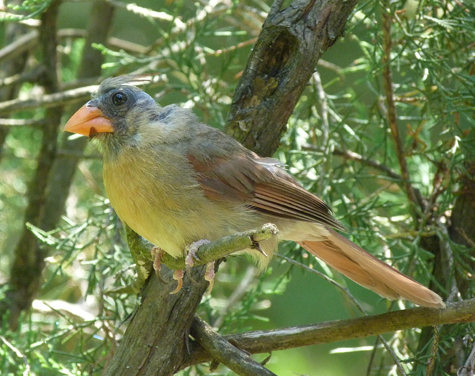
The eggs have hatched, although I don’t really know exactly when they hatched. I noticed our female sitting on the nest the previous day and the next morning (7/26) but she could have been just shielding the nestlings from the sun. The birds look rather young, so they must have hatched within a day or two.
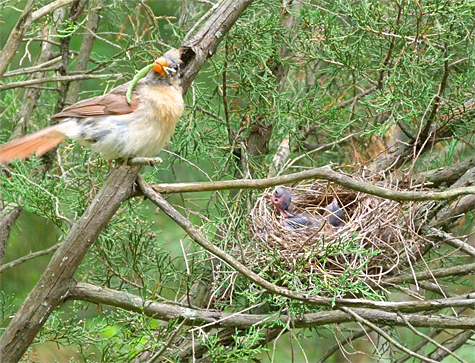
I watched the female bring in food several times, a few times accompanied by the male. But she, the female, appeared to be the busiest of the two adults; I could hear the male off singing as the female brought in grub for the kids.
At one point I thought that there was going to be a little trouble at the nest, a Carolina Wren flew in to see what was going on. The female cardinal was close by and the wren left without incident. I don’t know what the wren may have done, if anything, but it seemed very curious as to the goings on around the cardinal’s nest.
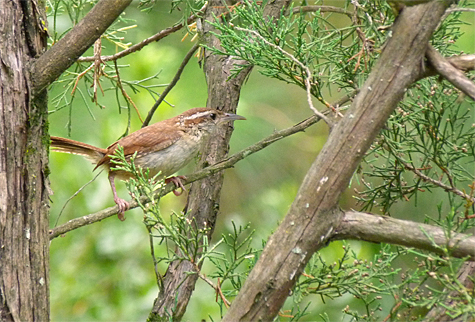
The nest, as mentioned in the previous post about this nest, is poorly made, the nestlings can be seen from the ground. I did not climb up on a ladder, stand on a log or elevate myself in any manner to get the shots you see here. The nest tilts to the side making it easy to photograph from below.
With such great views of the nest, and the birds’ being naked with just a hint of the various feathers tracts growing in, I thought it interesting to note some bird anatomy. Look at the photo below and you can see the nestling’s ear, the round hole on the side of the head. The ear is not visible after the feathers grow in.
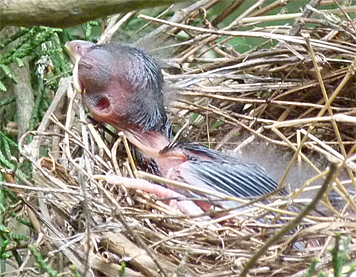
Another interesting fact about birds is that in many species the nestling’s feces comes out of the cloaca (rear end) in a neat little package called a fecal sac, at least during the early stages of their nestling lives. This fecal sac makes cleaning the nest a snap, all the parent has to do is pick up the sac and dump it somewhere away from the nest. Later, the nestlings develop enough motor skills to lift their rears ends over the side of the nest and get rid of their own waste.
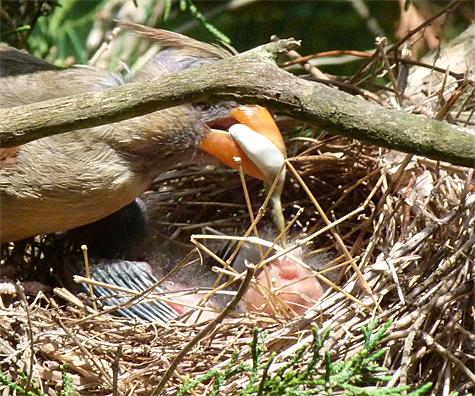
I watched the female remove a fecal sac from both nestlings on the same trip to the nest. She ate both of them. It’s not as uncommon as it might seem that the parents will eat the fecal sac in the early stages of the nestling period, supposedly there’s still nutritional value in the feces.
By the way, the catbird nest that was mentioned in the original Journal entry about this cardinal’s nest has been abandoned. I don’t have an answer as to why, perhaps a snake visited the nest, but I haven’t seen any activity at the nest in over a week.